Breaking Down the Costs: What to Expect when installing an EV Charging Station
We look at four factors to determine a quote for installing a home charging station for your electric car: Where is power available, how much power is available, where would you like the charging station installed, and what will the run between the two points look like.
Where is power available?
Most homes have two breaker panels, a main breaker panel is almost always outside and a subpanel almost always in the garage. There are certainly homes that don’t fit this narrative like homes that were built with only a main breaker outside so all of the breakers are housed inside, some homes have multiple subpanels, some homes have detached garages with no power available inside. For this purpose we’ll talk about the most common setup we see which is the standard house with an attached garage where the main breaker panel is on the outside of the home and the subpanel is on the inside of the garage.
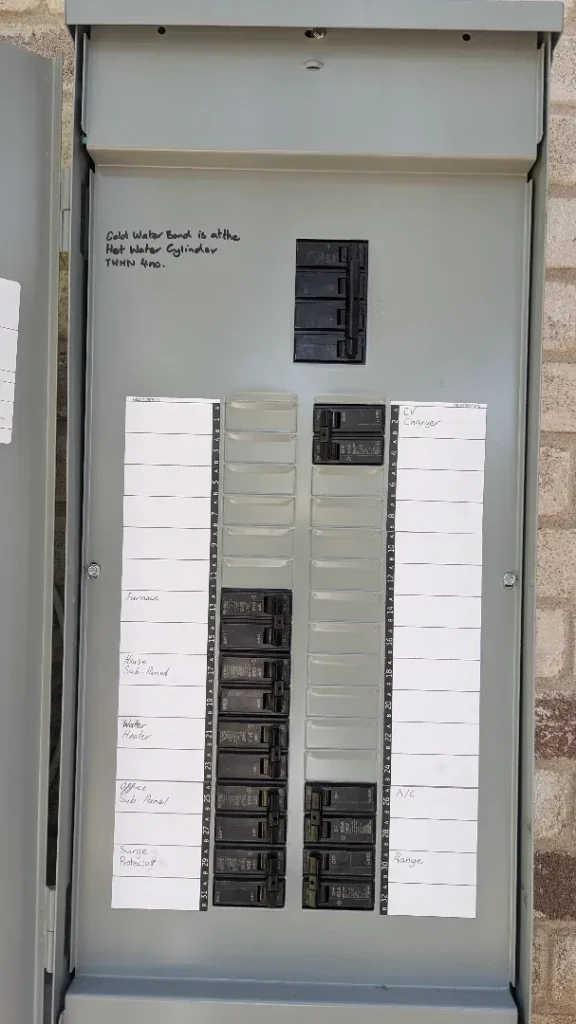 | 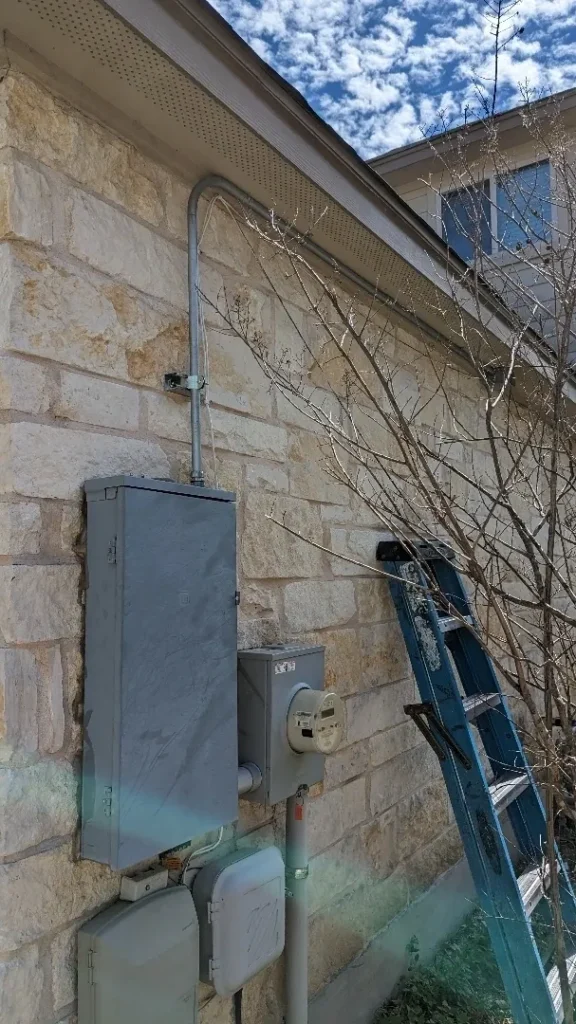 | 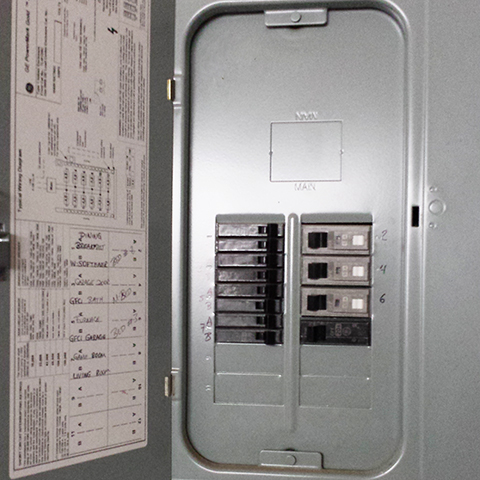 |
| Main Breaker Panel | Main Breaker Panel and Electric Meter | Subpanel located in the Garage |
From the power provider, all of the available power to the home is first sent through the electric meter and then into the main breaker panel. For most homes in the Austin area the main breaker will have the number 150 or 200 written on the handle. Typically, in the main breaker panel we’ll see breakers for large items like the air conditioner, maybe a pool panel, sometimes an outdoor circuit, and the breaker for the subpanel. In most builder homes the subpanel is fed with a two-handled 60 amp breaker. To avoid any confusion, the double handle just means that it’s a 240-volt circuit at 60 amps, it’s not a 120 amp circuit, the two sides aren’t added together. From the main breaker panel, 60 amps goes to the subpanel and that panel typically feeds the small circuits inside the home like the bedrooms, bathrooms, and appliance circuits in the kitchen and laundry rooms. If you have any trouble with a circuit in the house the breaker is usually housed in the subpanel.
What we’re looking at here is how much power is being given to the house from the power provider, usually 150 or 200 amps and from that how much power is being used by the home?
How much power is available?
This is where we take the pictures provided in the quote form to create a load calculation for the home. The load calculation comes from the National Electrical Code to determine of all the power coming in and all the circuits being used, how much power is left over for other things that we’d like to install like a car charging station. The whole home will have a load calculation and each breaker panel will ultimately have it’s own separate load calculation which tells us how much power is available in each breaker panel. The last thing we want to create is a situation in which the breaker panel can’t handle the load of the new car charger. Often we see problems arise when a homeowner has a 60 amp subpanel in the garage, it feeds almost all of the small circuits in the home, and has also been wired to try to support a car charging station in the garage. The logical explanation is that someone either thought the panel was nearby so it must work or they assumed that it probably wouldn’t be a problem. In many cases, the subpanel doesn’t have enough power to support a car charger so we often need to pull the new EV charging station circuit from the main breaker panel on the outside of the home.
Where do you want the charging station installed?
We recently wrote a post about how to decide where to install the charging station which you can read here. The short answer is that electrically, we can place the wiring for the charging station anywhere, but the location is largely personal preference. Whether you pull into the garage or back in you might choose to place the charging station in a different location. The location most often requested is near the garage door since most people pull into their spaces and the charging ports on many cars are toward the back of the car.
What does the run between the two points look like?
In a perfect world the main breaker panel would always be on the outside of the garage. Why isn’t it? Before the home is built the plans are drawn up and submitted to the city if permitting is required and the power provider. The power provider will take a look at the lot and determine how best to bring power to the property. If we’re talking about a large community like a new neighborhood the power provider will bring power to the middle of every two lots. If the power on our house as viewed from the street is on the left side of our house then the power on our neighbors house will be on their right. The location of the power could be largely determined before the plans of the house are finalized. Essentially, we get what we get and we find a way to make it work.
Back to Back
Sometimes we get lucky and the main breaker panel is located on the outside of the garage. The easiest location for us to install a charging station is directly back to back with the main breaker panel. That’s not always the best location for someone whether the main breaker panel is at the wrong end of the garage or they’d like the charging station on the opposite side of the garage. In either case, we often end up running surface mounted conduit in order to get power to our ideal location. If we need to cross the garage the conduit often crosses along the ceiling over the garage door and comes down the wall and directly into the back of the charging station.

Crossing the Home
Sometimes we’re not so lucky and the main breaker panel is placed on the opposite side of the home from the garage. That’s okay, we can still get the power to where we need it. Most often whether the house is single story or two-story we’ll place the wiring in surface mounted conduit and go straight up from the breaker panel until we get to the attic, we’ll cross the attic with the wiring, and come down on the opposite side of the home. If the home is single story we can often place the wiring in the wall of the garage. If the home is two-story we often run the wiring in conduit down the wall of the house as inconspicuous as possible and bring the circuit into the garage.
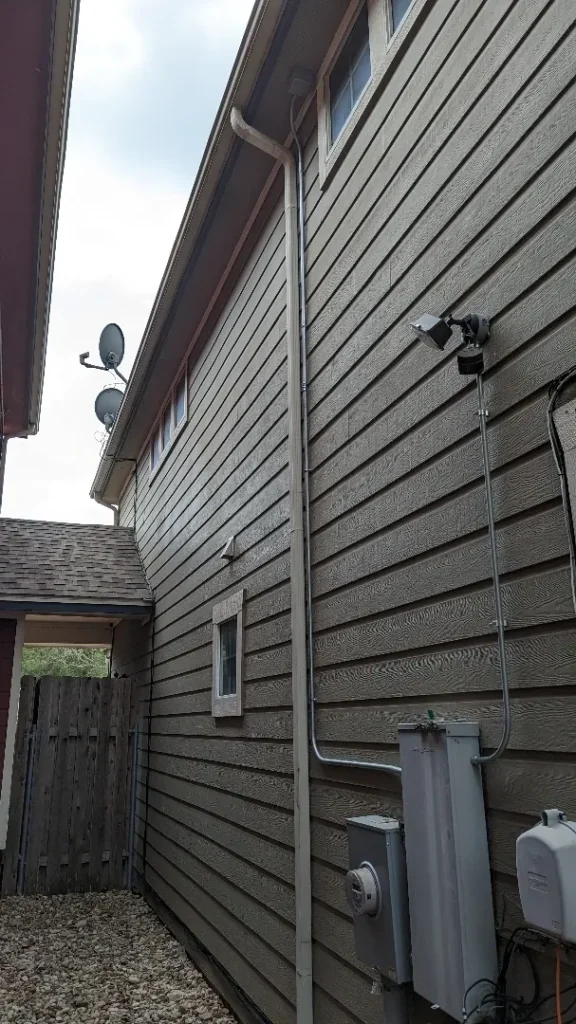
Crossing the Porch
In a few homes, depending on the construction, it makes the most sense to cross the front porch with surface mounted conduit to go from the main breaker panel into the garage. Anytime we’re talking about using conduit we’re always talking about a metal conduit versus flexible conduit. Metal conduit is going to hold up better over time and it’s paintable to match the trim color on the house if you’d like to paint it to blend in a little better.
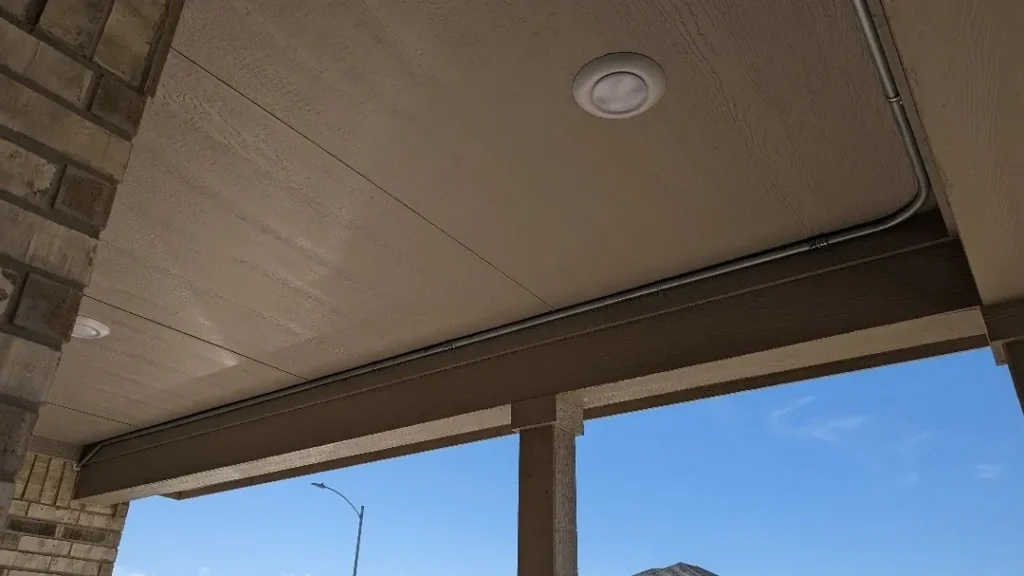
Running the Power Underground
Running power underground is something we avoid for many reasons, crossing previously buried utilities being the main obstacle, but digging in the rock underneath Austin is also at the top of that list. The only time that immediately comes to mind that it’s best to bury wiring underground for a car charger circuit is when there’s a detached garage that doesn’t have power or doesn’t have enough power available. Burying wiring underground to go to an attached garage just doesn’t make sense when we have other options that in our opinion are better options available.
Other slightly unexpected costs
There are some other costs we could potentially run into, we call them slightly unexpected because they’re not typical but they’re not unusual either. So while they may be unexpected to a homeowner they’re not completely unexpected to us.
Replacing a Breaker Panel
There are a few reasons we may need to replace a breaker panel:
- When there’s not enough power available
- When there’s not enough space available
- When the breaker panel doesn’t meet the minimum requirements for passing an inspection
In some cases we can install a charging station with load management equipment that sends all available power to the car at any given moment. This means that you should never have to choose between putting dinner in the oven and charging the car. The charging station will determine that when dinner is cooking in the oven less power is available thus turning the charging rate down until the oven is turned off and more power is available to send to the car.
There are time when space initially looks like a problem but space can be created by replacing a thick GE breaker with a thinner version of the same size of breaker. In some panels we can create the space we need in order to make room for a new car charging circuit breaker.
Keep in mind that replacing a breaker panel is not something that we take lightly, it’s costly and depending on the power provider can be something that we wait a while to do. We’re looking at you Austin Energy. If we can safely install a car charging circuit without replacing the breaker panel, that’s going to be our first choice. The key to the decision is whether it meets the criteria of safety.
Adding a Whole Home Surge Protector
Whole home surge protection is something that’s been creeping up in popularity over the last decade thanks to people starting to talk about it, recommending it, and the National Electrical Code writing it into current code for all new breaker panels. For anyone not planning to replace their breaker panel anytime soon it’s still an optional measure.
I compare a whole home surge protector to a dam. In the same way that the dam holds back as much flood water as it can, the surge protector reroutes as much excess power as it can to the home’s grounding system. In newer homes the grounding system is going to the in the slab of the home, in older homes it’s going to be ground rods driven into the earth. The grounding system gives that excess power a path of least resistance and the surge protector puts a block in the system to guide that power in the right direction. Often, when we see problems arise from lightning strikes the excess power takes what seems like a random path through the house, it might affect the tv in the living room, the dryer in the laundry room, and the lights in the kitchen. While it may seem random to us it’s the path of least resistance, anything with a high resistance is like flood water trying to run uphill. Just as a dam can fail if given the right circumstances the whole home surge protector is equally as fallible, nothing is 100% effective but it can be a useful tool when needed.
The whole home surge protector is something we recommend, we’ve personally put it on the houses we’ve lived in. It’s an optional line item that we add to every car charing circuit installation unless the home already has one installed.